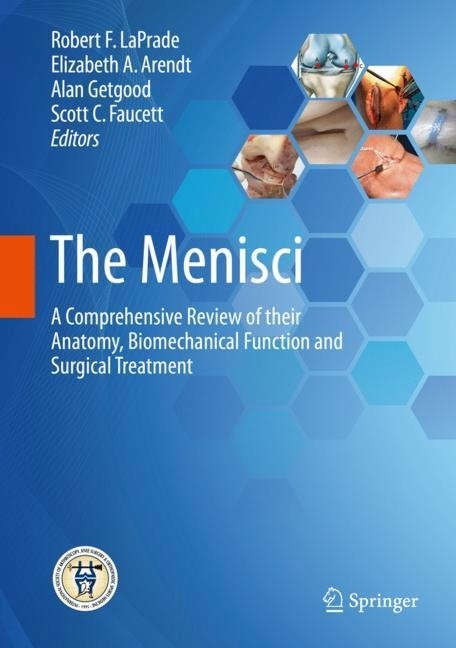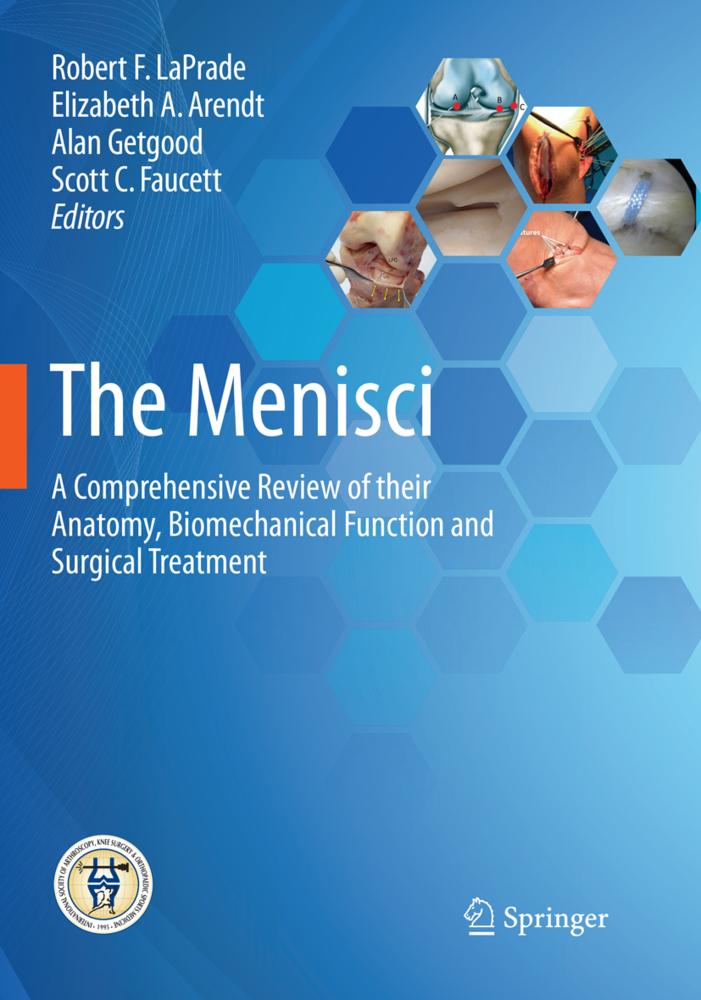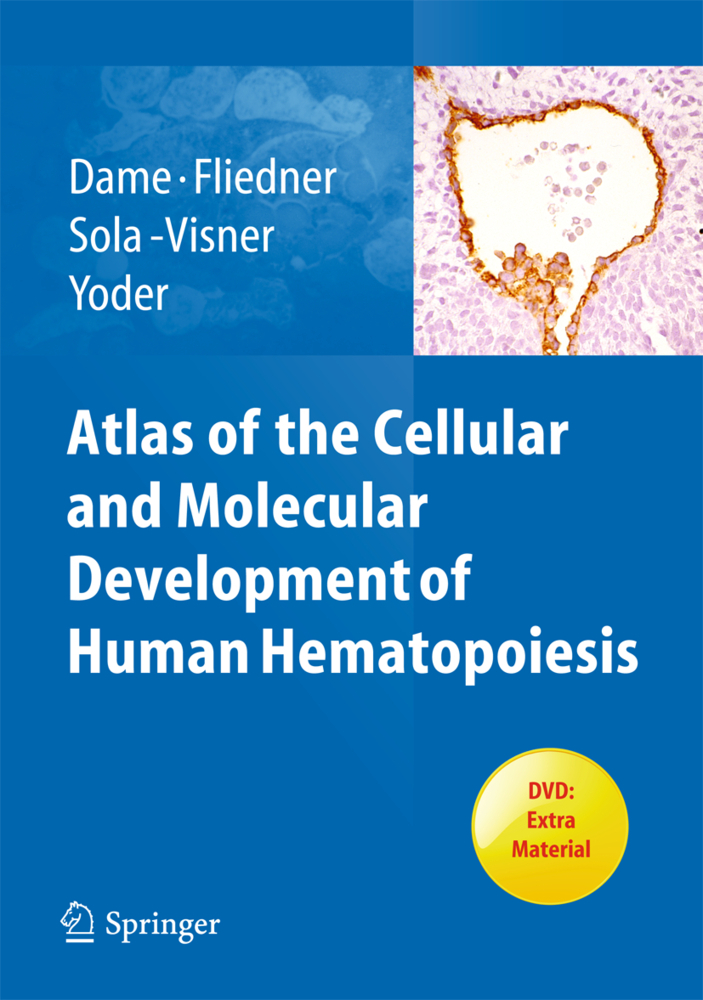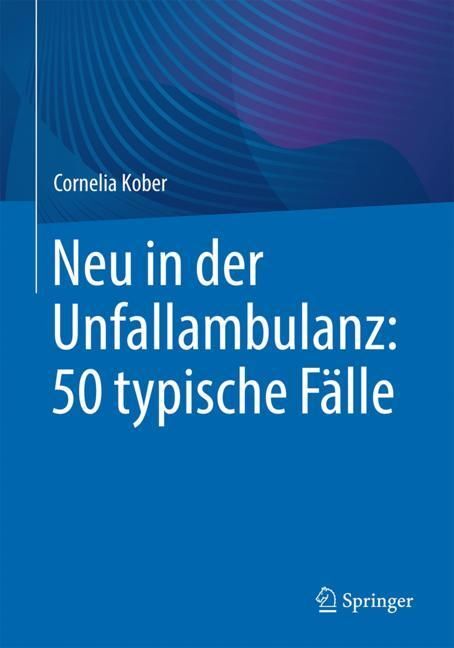The Menisci
A Comprehensive Review of their Anatomy, Biomechanical Function and Surgical Treatment
This book is a comprehensive journey through the pathogenesis and treatment of meniscal pathology. It details the elements that are necessary to properly understand, diagnose, and treat meniscal tears, ranging from vertical tears to radial tears and root avulsions. Treatment techniques are thoroughly described and illustrated, with presentation of the latest evidence on outcomes.
The algorithmic treatment of meniscal tears has undergone a rapid transformation. We have progressed from the initial treatments involving removal of the meniscus using an open technique, to the performance of partial meniscectomies and complex meniscal repairs by means of an arthroscopic technique. The current treatment goal is to maintain the biology and mechanical integrity of this vital knee structure, an aim too often disregarded by past generations of surgeons. An explosion of new knowledge, coupled with advances in arthroscopic and surgical technology, has paved the way for wider application of approaches that help to preserve the meniscus, in the hope of preventing or delaying the development of knee arthritis. This book will have utility for all clinicians who treat meniscal lesions and will serve as a valuable resource for years to come.
Robert F. LaPrade, MD, PhD, is a Complex Knee and Sports Medicine Surgeon at the Steadman Clinic in Colorado, USA, where he is Co-Director of both the Sports Medicine Fellowship Program and the Athletic Training Fellowship Program. In addition, he is Chief Medical Officer at the Steadman Philippon Research Institute and Affiliate Faculty in the Department of Clinical Sciences, College of Veterinary Medicine & Biomedical Sciences, Colorado State University. Dr. LaPrade is currently Chair of the ISAKOS Sports Medicine Committee and a member of the ISAKOS Program Committee. He is also a member of the American Journal of Sports Medicine (AJSM) Ethics Committee, a member of the American Orthopaedic Society for Sports Medicine (AOSSM) Board of Directors, and AOSSM Research Chair. He has published 276 articles in peer-reviewed journals and was editor of the 2006 book Posterolateral Knee Injuries: Anatomy, Function and Treatment (Thieme, New York) as well as co-editor of a recent iBook, Complex Knee Surgery Made Easy.
The algorithmic treatment of meniscal tears has undergone a rapid transformation. We have progressed from the initial treatments involving removal of the meniscus using an open technique, to the performance of partial meniscectomies and complex meniscal repairs by means of an arthroscopic technique. The current treatment goal is to maintain the biology and mechanical integrity of this vital knee structure, an aim too often disregarded by past generations of surgeons. An explosion of new knowledge, coupled with advances in arthroscopic and surgical technology, has paved the way for wider application of approaches that help to preserve the meniscus, in the hope of preventing or delaying the development of knee arthritis. This book will have utility for all clinicians who treat meniscal lesions and will serve as a valuable resource for years to come.
Robert F. LaPrade, MD, PhD, is a Complex Knee and Sports Medicine Surgeon at the Steadman Clinic in Colorado, USA, where he is Co-Director of both the Sports Medicine Fellowship Program and the Athletic Training Fellowship Program. In addition, he is Chief Medical Officer at the Steadman Philippon Research Institute and Affiliate Faculty in the Department of Clinical Sciences, College of Veterinary Medicine & Biomedical Sciences, Colorado State University. Dr. LaPrade is currently Chair of the ISAKOS Sports Medicine Committee and a member of the ISAKOS Program Committee. He is also a member of the American Journal of Sports Medicine (AJSM) Ethics Committee, a member of the American Orthopaedic Society for Sports Medicine (AOSSM) Board of Directors, and AOSSM Research Chair. He has published 276 articles in peer-reviewed journals and was editor of the 2006 book Posterolateral Knee Injuries: Anatomy, Function and Treatment (Thieme, New York) as well as co-editor of a recent iBook, Complex Knee Surgery Made Easy.
1;Preface;5 2;Contents;6 3;1: Meniscus Anatomy;8 3.1;1.1 Introduction;8 3.2;1.2 Medial Meniscus;8 3.2.1;1.2.1 Zone 1: Anterior Root;8 3.2.2;1.2.2 Zone 2: Anteromedial Zone;9 3.2.3;1.2.3 Zone 3: At the Level of the Medial Collateral Ligament;10 3.2.4;1.2.4 Zone 4: Posterior Horn;10 3.2.5;1.2.5 Zone 5: Posterior Root;10 3.3;1.3 Lateral Meniscus;10 3.3.1;1.3.1 Anterior Root;10 3.3.2;1.3.2 Anterior Horn;11 3.3.3;1.3.3 Area at the Level of Hiatus Popliteus;11 3.3.4;1.3.4 Meniscofemoral Ligaments;13 3.3.5;1.3.5 Posterior Root;13 3.4;Bibliography;14 4;2: The Biomechanical Function of the Menisci;16 4.1;2.1 Introduction;16 4.2;2.2 Microscopic Composition of Menisci and How It Relates to Function;16 4.3;2.3 Biomechanical Properties of Menisci;17 4.3.1;2.3.1 Viscoelasticity;17 4.3.2;2.3.2 Response to Compression;18 4.3.3;2.3.3 Response to Tension;19 4.3.4;2.3.4 Response to Shear;19 4.4;2.4 Functional Properties of Menisci;19 4.4.1;2.4.1 Size, Shape, and Load Transmission;19 4.4.2;2.4.2 Joint Stability;20 4.4.3;2.4.3 Lubrication and Nutrition;20 4.4.4;2.4.4 Proprioception;21 4.4.5;2.4.5 Shock Absorption;21 4.4.6;2.4.6 Functional Movements of Menisci;21 4.5;2.5 Pathology Resulting in a Dysfunctional Meniscus;21 4.6;2.6 Meniscus-Associated Ligaments;22 4.6.1;2.6.1 Anterior Intermeniscal Ligament (Transverse Geniculate Ligament);22 4.6.2;2.6.2 Coronary Ligaments;22 4.6.3;2.6.3 Meniscotibial Ligaments;22 4.6.4;2.6.4 Deep Medial Collateral Ligament (dMCL);23 4.6.5;2.6.5 Anterior and Posterior Meniscofemoral Ligaments (aMFL/pMFL);23 4.6.6;2.6.6 Meniscofibular Ligaments;23 4.7;References;23 5;3: Classification of Meniscal Tears;28 5.1;3.1 Introduction;28 5.2;3.2 Classification of the Meniscal Tears;28 5.2.1;3.2.1 Trillat's Classification;29 5.2.2;3.2.2 MRI Classification of Meniscal Tears;29 5.2.3;3.2.3 ISAKOS Classification;29 5.2.3.1;3.2.3.1 Tear Depth;29 5.2.3.2;3.2.3.2 Tear Location: Rim Width;29 5.2.3.3;3.2.3.3 Local Tear: Radial Location;31 5.2.3.4;3.2.3.4 Patterns of Meniscal Tears;31 5.2.3.4.1;Longitudinal Vertical Tear;31 5.2.3.4.2;Horizontal Meniscus Tear;31 5.2.3.4.3;Radial Meniscus Tear;31 5.2.3.4.4;Flap or Parrot-Beak Tears;31 5.2.3.4.5;Complex Tears, Degenerative Flap;31 5.2.4;3.2.4 Classification of Discoid Meniscus;32 5.2.5;3.2.5 Classification of Degenerative Meniscal Tears;32 5.2.6;3.2.6 Meniscal Root Tears;33 5.2.7;3.2.7 Classification of Medial Meniscal Capsular Tears;34 5.3;References;35 6;4: Meniscectomy: Updates on Techniques and Outcomes;37 6.1;4.1 Introduction;37 6.2;4.2 Updates on Meniscectomy Techniques;38 6.2.1;4.2.1 Tourniquet, Inflow Pump and Arthroscopic Portals;38 6.2.2;4.2.2 Techniques to Improve Meniscectomy Execution;40 6.2.3;4.2.3 Video Device;41 6.3;4.3 Updates on Meniscectomy Outcomes;42 6.3.1;4.3.1 Inflammation Markers and Meniscectomy;44 6.3.2;4.3.2 Age, Gender, BMI, Functional Request and Meniscectomy;45 6.3.3;4.3.3 Knee Adaption and Meniscectomy;45 6.3.4;4.3.4 Return to Play and Meniscectomy;46 6.3.5;4.3.5 Complications and Meniscectomy;46 6.3.6;4.3.6 Evidence-Based Medicine (EBM) and Meniscectomy;47 6.4;References;51 7;5: Meniscal Root Tears: A Missed Epidemic? How Should They Be Treated?;54 7.1;5.1 Introduction;54 7.2;5.2 Anatomy;55 7.3;5.3 Meniscal Root Biomechanics;55 7.4;5.4 Natural History of Root Tears;56 7.5;5.5 Diagnosis;56 7.5.1;5.5.1 Physical Examination;56 7.5.2;5.5.2 Imaging;58 7.6;5.6 Classification Systems;59 7.7;5.7 Treatment;59 7.7.1;5.7.1 Transtibial Pullout Repair for Posterior Meniscus Root Tears;60 7.8;5.8 Postoperative Rehabilitation;62 7.9;5.9 Outcomes;62 7.10;References;64 8;6: Meniscal Ramp Lesions: Diagnosis and Treatment Strategies;67 8.1;6.1 Introduction;67 8.2;6.2 What Is a Ramp Lesion?;67 8.3;6.3 How Do Ramp Lesions Occur?;68 8.4;6.4 How Common Are Ramp Lesions?;69 8.5;6.5 Why Are Ramp Lesions Important?;69 8.6;6.6 How Do You Diagnose a Ramp Lesion?;70 8.7;6.7 How Can I See a Ramp Lesion Arthroscopically?;71 8.8;6.8 If I See a Ramp Lesion, How Should I Treat It?;73 8.9;6.9
LaPrade, Robert F.
Arendt, Elizabeth A.
Getgood, Alan
Faucett, Scott C.
| ISBN | 9783662537923 |
|---|---|
| Artikelnummer | 9783662537923 |
| Medientyp | E-Book - PDF |
| Copyrightjahr | 2017 |
| Verlag | Springer-Verlag |
| Umfang | 198 Seiten |
| Sprache | Englisch |
| Kopierschutz | Digitales Wasserzeichen |









